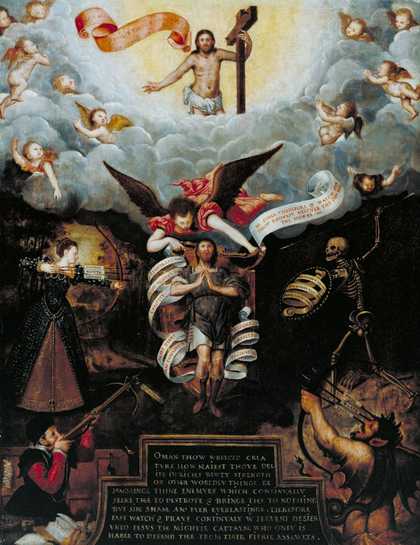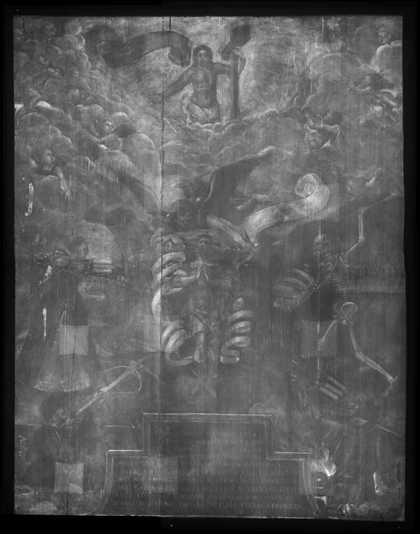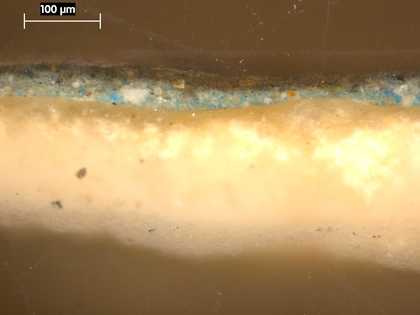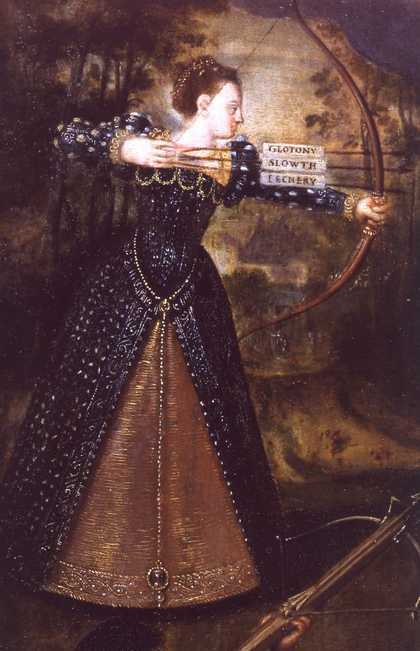
Fig.1
British School 16th Century
An Allegory of Man 1596 or after
Oil paint on panel
570 x 514mm
T05729
This painting is in oil paint on a wooden panel measuring 570 x 514 mm (fig.1). The panel is composed of three vertical oak boards of different widths, glued together at butt joints (figs.2–3). The boards are on average 9mm thick. Dendrochronological examination established that the oak is from the Baltic region with an earliest felling date of 1588 and probable earliest usage date of 1596.1 As described in the curatorial entry on this painting, this makes it likely that the painting is either a copy after an earlier original by Hans Eworth, who died c.1574 and whose style it resembles, or a painting done in his manner.

Fig.2
X-radiograph of An Allegory of Man 1596 or after

Fig.3
The back of the panel, photographed in black-and-white
The joined panel was prepared with a white ground composed of chalk bound in animal glue (fig.4).2 The painting gives us very few clues about its evolution on the prepared panel. Hardly any linear underdrawing is visible with either the stereomicroscope or with infrared reflectography. Templates existed for the multiple production of portraits, for example, and, if the painting were an example of a retrospective style being produced in a studio, one might expect their use here.3 The evidence would be in the form of dotted lines from ‘pouncing’ or continuous lines from tracing, but no preparatory design is visible apart from a line of drawing off-set from the final painted outline of the archer’s arm, and what might be three marker-dots and a drawing-line in the profile of the lady’s face, which are all visible in infrared reflectography. There might be a trace of black drawing in a cross-section from the devil. Yet the putti, for example, are not painted on top of the sky but directly onto the ground in the same phase as the clouds, which would argue for a detailed preconception of their positioning. Again this would indicate that the painting is a copy.

Fig.4
Cross-section through green foliage in the lower left corner, photographed at x320 magnification. From the bottom: white ground; bright, opaque bluish green underpainting; translucent green glaze
Some of the cross-sections show the presence of thin underpainting in some areas. The once-green landscape behind the lady and in the grass at her feet were first painted with opaque, light green mixtures containing lead white, azurite and yellow ochre (figs.4–5).

Fig.5
Detail of the lady in an area that originally was bright green
After this paint had dried it was glazed over with the brilliant, translucent green, copper resinate. It must have looked jewel-like and very beautiful. Now, however, its brown tones belie the vista; the paint has discoloured permanently as a result of exposure to light. The brown cave-like area behind the skeleton has a thin, pale grey, slightly gritty-looking underpaint, which appears to be present beneath the black inscription also. The figures of Christ and the putti appear to have been sketched in first very thinly with pale grey paint, which has lead white as its principal component. The visible colours were mixed on the palette and applied mainly wet-in-wet to the panel. Details such as lettering, highlights and embroidery were then applied on top, as were the glazes of red lake in the shadows of the angel’s robe and in the scrolled banner next to Christ. The yellow sky is lead-tin yellow and the bluish grey areas contain lead white, black and smalt.4 The putti were made from mixtures of lead white with some earth pigments, red lake, ivory or bone black and vermilion. Only lead white and an organic lake appear in the angel’s flesh tones. Down in the terrestrial regions the lady’s petticoat consists of ochres with ivory or bone black, the detailing applied on top in lead white and lead-tin yellow. Vermilion appears in all the flesh tones in this region and in the lettering around the figure of Man and is mixed with red lake for the archer’s sleeves. The dark brown, shadowy areas behind the skeleton contain ivory or bone black and vermilion. Apart from the discoloured green area, the black inscription and the brown behind the skeleton, which are all in a resinous or oleo-resinous medium, the painting appears to be painted in unmodified drying oil.
September 2009
